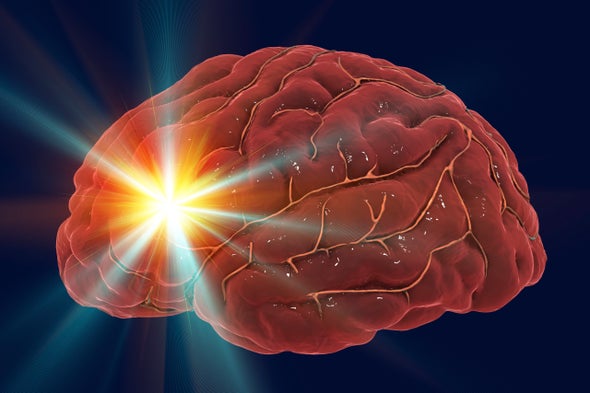When a clot blocks off circulation to the brain during an ischemic stroke, the loss of oxygen and nutrients can cause tissue to become damaged and die. Physicians have effective methods of clearing these occlusions: clot-busting proteins called tissue plasminogen activators and thrombectomy, a surgical technique. Removing the blockage is critical, but even after blood flow is restored, complications brought on by inflammation can lead to more cell death. Despite a decades-long search, scientists have yet to pinpoint effective ways of protecting the brain from poststroke damage. In recent years, a new potential player in stroke outcome has emerged: the microorganisms in our guts.
Some of the first findings linking gut microbes to stroke just appeared about three years ago. In one study, researchers in New York City reported that interrupting the diversity of intestinal flora in mice with antibiotics affected the amount of brain damage caused by stroke. Another investigation in rodents, conducted by a German team, demonstrated that strokes disrupted mouse microbiomes—and that the altered composition of gut microbes could worsen outcomes after stroke. That research meant “2016 was a fantastic year for the gut-brain axis in the stroke field,” says Connie Wong, a stroke scientist at Monash University in Australia, who was not involved in the studies
The work has continued. More recently, Venugopal Venna, a stroke researcher at the University of Texas Health Science Center at Houston, and his colleagues have been examining whether age-related changes to the microbiome affect recovery. “Stroke is mainly a disease of aging,” Venna says. “Young people also get stroke but much less often.” In a study reported in Annals of Neurologylast year, Venna and his colleagues examined whether age-related changes to the microbiome would influence recovery in mice. The scientists first depleted the rodents’ gut microbes with antibiotics, then used fecal pellets to introduce microbiota from either young or old animals. When the team induced ischemic strokes in the rodents a month later, it found that young mice with older microbiomes had worse outcomes than their counterparts with intestinal flora from younger animals. They had higher rates of mortality, greater neurological deficits, slower recovery of muscle strength and movement, and increased levels of inflammatory molecules. Meanwhile elderly mice fared better with young microbiomes than old ones.
The big question now is the mechanism mediating the microbiome’s effect on stroke outcome, says Arthur Liesz, a neurologist at Ludwig Maximilian University of Munich, whose group authored the German 2016 study. Among the multiple possibilities, several researchers are currently investigating microbial metabolites. Venna’s team has homed in on short-chain fatty acids, compounds generated via bacterial fermentation of fiber in the intestine. Its 2018 study showed that short-chain-fatty-acid levels were lower in animals with old microbiomes, so Venna and his colleagues hypothesized that these compounds might be involved in stroke recovery. To test this theory, they selected strains of gut bacteria that produced short-chain fatty acids and transplanted them into mice—and found that these microorganisms were enough to improve outcomes after stroke. Venna presented these unpublished results at last month’s Society for Neuroscience (SfN) meeting in Chicago.
Venna and others suspect that gut-microbe metabolites such as short-chain fatty acids may help keep the immune system—and thus inflammation—in check in healthy animals and that this equilibrium state is altered after stroke. Supporting this idea, Liesz’s group also presented unpublished work at the SfN meeting demonstrating that, in rodents, both short-chain fatty acids and indoles—gut-microbe metabolites produced from digesting the amino acid tryptophan—modified the activity of immune cells following a stroke. “There are lots of questions that still need to be answered, but we’re fascinated with the results so far,” Venna says.
Most of the findings supporting the microbiome’s role in stroke have stemmed from research in animals, so whether the benefits will carry over to humans remains to be seen. There are some small observational studies in people, but Liesz notes that larger, more long-term investigations are essential. To address this need, his lab is currently recruiting patients to procure their feces and blood to determine whether their intestinal flora and circulating metabolites reflect what is seen in mice. Although clinical trials are still far off, “I think many of us do think about treatments at this very early stage,” Liesz says. Targeting the gut using methods such as probiotics or fecal transplants, he adds, “might be a very elegant way to treat a complex disease like stroke by not directly affecting the brain but using the microbiome as a way to sneak into the system.”
Not everyone agrees that the evidence linking the microbiome to stroke outcome is compelling, however. Ulrich Dirnagl, a neurologist and stroke scientist at Charité University Hospital in Berlin, says that there are some major limitations in the research conducted to date. One key issue: because laboratory animals are raised in a very artificial environment—typically in clean cages and on a limited diet, for example—their microbiome does not accurately represent the diversity of gut microbes found in wild animals. For this reason, he explains, experiments conducted with lab mice may not be relevant to humans.
A paper published in August in Science supports Dirnagl’s concerns. In that study, researchers generated so-called wildling mice by implanting embryos from lab animals into wild mice. Because of exposure to the wide range of microorganisms in their surrogate mothers, the wildlings had a microbiome that was a closer match to those found in natural environments. When the team tested two immune-system-targeting drugs that had previously succeeded in lab mice but failed in humans, they found that the therapies were also unsuccessful in the wildlings. “The type of work that’s done now by stroke researchers is really far off from real life,” Dirnagl says, adding that there is also the issue of small samples sizes and a lack of replicated studies. “Extraordinary claims need extraordinary evidence. And I haven’t seen extraordinary evidence, just extraordinary claims.”


